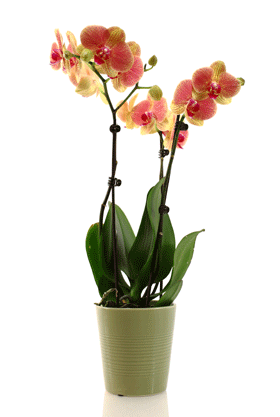
If your Phalaenopsis orchid starts to look “sick,” always start with the basics – water, light, location, humidity and temperature – before taking more drastic action. While Phalaenopsis hybrids are amazingly hardy orchids, orchids can be extremely sensitive to their environment. Your orchid may develop sick-like symptoms if exposed to too much or too little water, light, humidity, air flow or temperature. You may be able to solve the problem quickly and easily by moving your orchid out of direct sunlight or away from a drafty air duct. (Check our orchid care guide for optimal orchid growing conditions.)
If environmental issues and incorrect watering do not seem to be the source of your orchid’s distress, check your plant for signs of pest infestation and bacterial or fungal disease. If this appears to be the problem, isolate the plant to avoid spreading the disease or pests to other plants and treat as directed.
If all else fails, follow the repotting instructions in our orchid care video and repot your orchid. Remove any damaged plant material with a sterile knife before repotting and use only fresh, new orchid potting media to repot your plant. If your orchid has been exposed to pests or a disease, it should be repotted in a clean, new grower pot to prevent contamination from the old pot. Thoroughly scrub and sanitize the outer decorative pot before reusing or replace it with a new pot.
For more tips, click here to download our free orchid care tip sheet, 10 Simple Steps to Keeping Your Orchid Healthy.

Copyright Just Add Ice® Orchids 2023